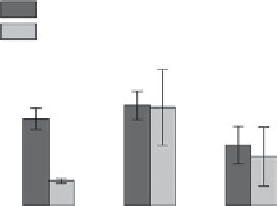Geoscience Reference
In-Depth Information
spring. The warm surface water in the stratified region has almost no nitrate
as a result of earlier uptake by the spring bloom. In the mixed region the water
contains intermediate nitrate concentrations, maintained by the vigorous tidal
mixing.
In the following sections we will detail the candidate mechanisms for this biochem-
ical response to shelf sea and island tidal mixing fronts. We will then look at some of
the links between fronts and higher trophic levels, and describe the role of the frontal
physics. You will see that simply linking higher phytoplankton biomass through to
the distribution of grazers and larger animals is not always justified by the observa-
tional evidence.
8.6.1
Enhancement of primary production at fronts
As the pattern of phytoplankton distribution at fronts became recognized, two
hypotheses arose to explain the association between the phytoplankton and the
temperature distribution. The weak, convergent current flow at the surface could
simply be concentrating the phytoplankton at the front, or the phytoplankton
enhancement could arise directly from in situ production due to some property of
frontal dynamics aiding access to nutrients and light. Direct evidence that a frontal
phytoplankton community actively grows came from the Georges Bank front (Horne
et al.,
1989
). The information on growth and nitrate uptake rates is summarized in
Fig. 8.14
. While the Georges Bank front has elevated carbon fixation rates, particu-
larly when compared to the stratified region, the main contrast lies in the high f-ratio
(see
Section 5.1.6
) and demand for nitrate at the front. The front is a site of elevated
new primary production.
What physical processes supply nitrate to surface frontal waters, leading to this
increase in new primary production? The schematic diagram in
Fig. 8.15
summarises
the biogeochemical environment and the possible nitrate supply mechanisms. There
are four possible ways to transfer nutrients across and into a front: (1) increased
vertical mixing allowed by the gradually weakening stratification at the front,
(2) periodic mixing and re-stabilisation of the frontal region due to spring-neap
adjustment, (3) eddy transfers across the front, and (4) fluxes associated with the
Figure 8.14
Carbon fixation rates and the
nitrate uptake rates, integrated through
the photic zone (upper 40 metres) at
mixed, frontal, and stratified sites across
the tidal mixing front on Georges Bank.
Numbers in brackets are the f-ratios
calculated as the ratio between nitrate
and nitrate
þ
ammonium uptake rates.
Based on observations reported in Horne
et al.,
1989
.
Carbon fixation rate
Nitrate uptake rate
2
400
1
200
0
0
Mixed
(0.27)
Front
(0.57)
Stratified
(0.40)








Search WWH ::

Custom Search